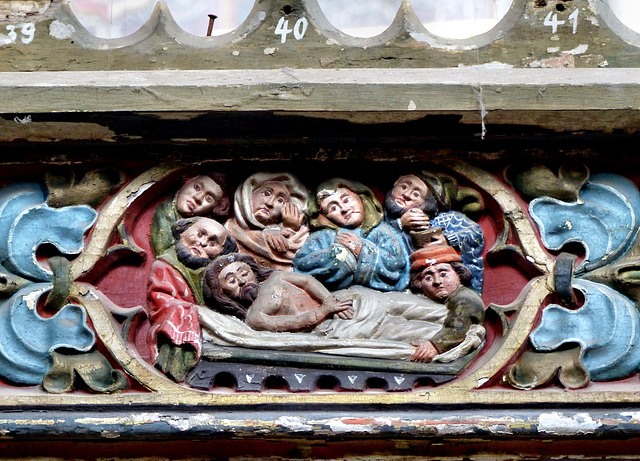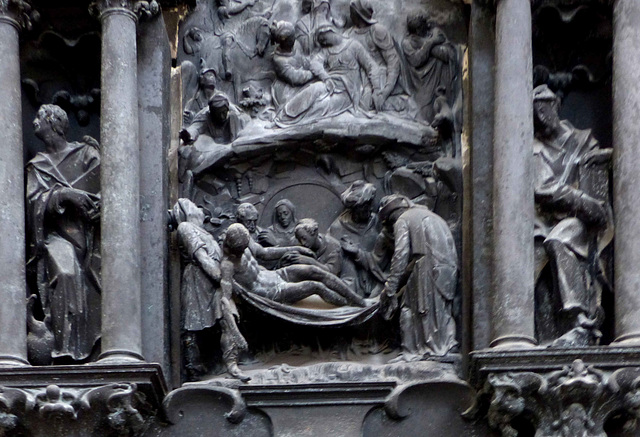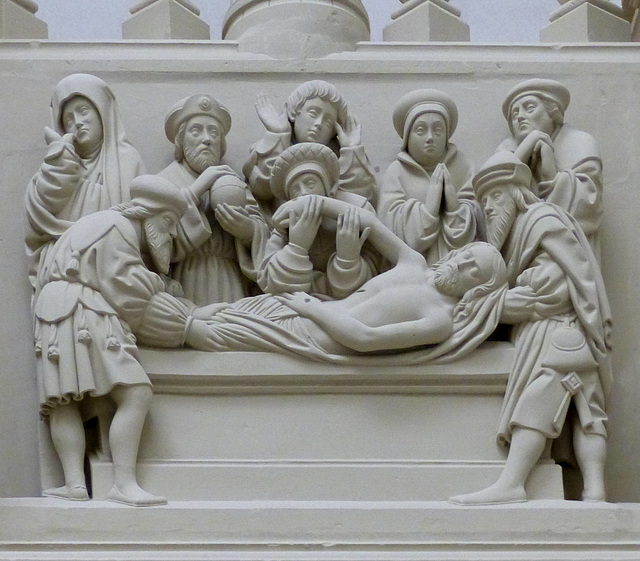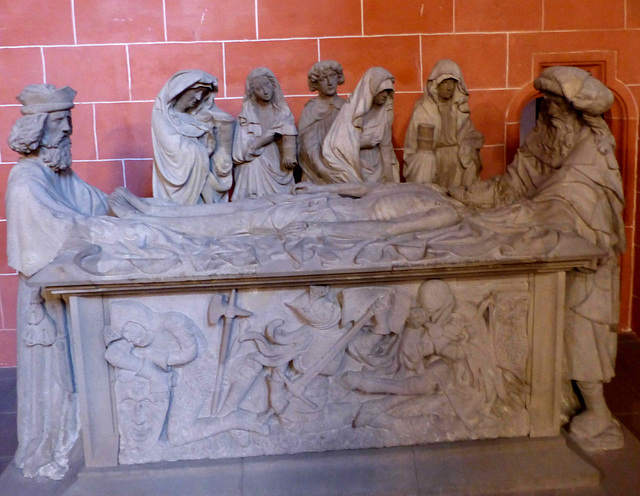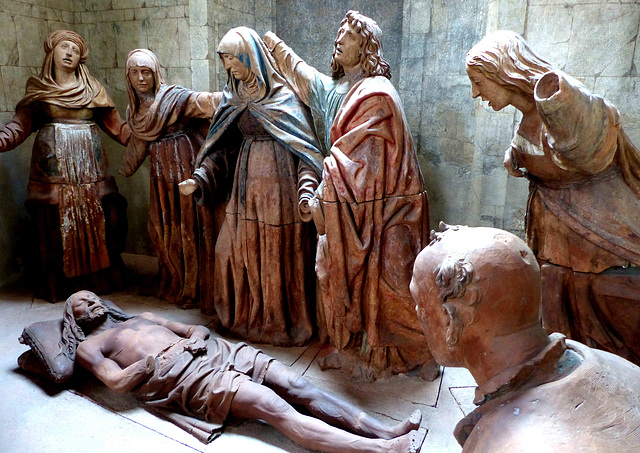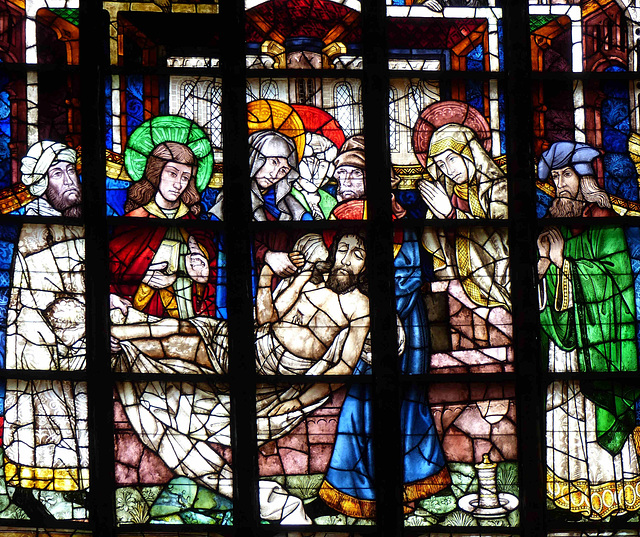
Mise au tombeau
The Entombment of Christ is known in art since the 11th century, though the icon was rarely seen in medieval times. At the beginning of the Renaissance the "Mise au Tombeau" got very popular in France.
Rostock - Kulturhistorisches Museum
With more than 200.000 inhabitants Rostock is the largest city in the state of Mecklenburg-Western Pomerania.
Small Slavic settlements existed already in the 8th century. A settlement named Roztok was founded in the 11th century by Polabian Slavs. This town was burnt down by troops of the Danish king Valdemar I in 1161. Afterwards the place was settled by German traders.
After 1226 Rostock became the seat of the Lordship of Rostock.
In the 1250s the city became a member of the Hanseatic League. In the 14th century, it was a powerful seaport town with 12,000 inhabitants and the largest city in Mecklenburg. Ships for cruising the Baltic Sea were constructed in Rostock. Until the last Hansa Convention in 1669, Rostock took a leading role in the Baltic Sea behind Lübeck.
-
The museum, founded mid 19th century, is hosted in the "Kloster zum Heiligen Kreuz", that got finally dissolved in 1920. The conversion into a museum began already in 1976, but the restoration of the buildings remained incomplete until 1997.
The winged Nonnenaltar (nun's altar) was created in the early 16th century. Its former location was in the church's nuns' gallery, thus the name. The wings show depictions from the legend of the finding of the cross by Empress Helena.
The entombment of Jesus and Christ's descent into hell. Both details of the predella.
Stralsund - Nikolaikirche
Slavic Ranen lived on the island of Ruegen and the mainland opposite the island. They were independent heathens up to the middle of the 12th century, and so maybe the last non-Christian people in Central Europe.
In 1168 Danish King Valdemar I defeated the Ranen and destroyed "Jaromarsburg" their main sanctuary. After the Danish victory, the Slavic princes became feudatories of the Danish crown and accepted the Christian faith.
They founded Strale, which prospered because of the rich herring stocks in the waters, many merchants settled here who saw this as their basis for trade. Already in 1234 Slavic Prince Wizlaw I granted the village the town charter (Lübsches Stadtrecht). Stralsund now became an important trading town in the Baltic region, mainly due to settlers from Westphalia. The German settlers clearly outnumbered the Slavic population already around 1300. From 1325 on Stralsund belonged to Pomerania-Wolgast. In the 14th century, it was the most important Hanseatic city in the southern Baltic region after Lübeck.
The 15th century was Stralsund's heyday. Long-distance trade was the most important economic factor. Around 1450, 350 merchants were involved in such trade. In 1488, 50 skippers founded the "St. Marienbruderschaft der Schiffer", the forerunner of the still existing "Stralsund Schiffercompagnie".
As early as 1525, the majority of Stralsund's citizens converted to the Protestant faith. After the Thirty Years' War Stralsund belonged to the Kingdom of Sweden for almost 200 years. In 1815 Stralsund came to Prussia.
-
The town hall and the Nikolaikirche form an impressive architectural ensemble. The planning and construction of the church went hand in hand with the planning of the town hall. The city council was even the trustee for the construction of the new church. The church was initially built as a hall church but following the example of Lübeck's Marienkirche, the unfinished Nikolaikirche was rebuilt into a basilica around 1270.
From the beginning, the church was built with brick produces in the region. Around 1308, the enclosing wall of the choir was closed. This is the result of dendrochronological investigations.
With the start of construction work on the new choir pillars, the eastern part of the predecessor church, which had still been used until then, was finally demolished. An invoice from 1314 for the ridge turret of the choir indicates the date of completion of this section.
Construction of the tower to the west began as early as 1300. Around 1314, when the tower had reached the height of the choir enclosure at 13 metres, the council decided to have two towers built.
Around 1350, the construction of the nave between the two towers was completed.
-
A small "Entombment of Christ". The icon "Mise au Tombeau" was very popular in France.
Magdeburg - Dom
Founded by Charlemagne in 805 as Magadoburg, the town was fortified in 919 by King Henry the Fowler against the Magyars and Slavs. In 929 King Otto I granted the city to his English-born wife Edith as dower. At her death, Queen Edith was buried in the crypt of the Benedictine abbey of Saint Maurice, later rebuilt as the cathedral. In 937, Magdeburg was the seat of a royal assembly. Otto I was buried as well in the cathedral.
In 1035 Magdeburg received a patent giving the city the right to hold trade exhibitions and conventions. This was the basis of town law to become known as the Magdeburg rights. These laws were adopted and modified throughout Central and Eastern Europe.
In the 13th century, Magdeburg became a member of the Hanseatic League. With more than 20,000 inhabitants Magdeburg was one of the largest cities in the Holy Roman Empire.
During the Thirty Years' War (1618–1648) Magdeburg was raided and probably 20.000 inhabitants lost their lives. A small group of 4000 people survived the "Sack of Magdeburg" by seeking refuge in the cathedral. Begging on his knees before the conqueror the head priest saved them.
-
The construction of the "Cathedral of Saints Catherine and Maurice" started in 1209. Two years ago, the church that had been in this place since 932, burnt down with most of the town. This church is influenced by the then-new gothic style, developed in France. Otto I the Great and his wife Edith of England have their graves here.
The construction stopped after 1274. In 1325, Archbishop Burchard III. was killed by the people of Magdeburg because of extreme taxes. Folklore says that especially the beer tax increase caused much anger. Afterward, Magdeburg was under a ban, and only after the donation of five atonement altars did the construction of the cathedral continue. In 1360 the construction stopped again for many decades. Only in 1477 did the construction start again. The towers were constructed by master builder Bastian Binder, the only master builder of the cathedral known by name. The construction of the cathedral was completed in 1520.
Although the cathedral was looted several times during its history, many valuable furnishings and art treasures have been preserved, which were moved out and secured during the bombardments of WWII.
-
The "Entombment of Christ" is a popular subject in art since the 11th century.
Hildesheim - Dommuseum
Louis the Pious founded the bishopric of Hildesheim in 815. The settlement developed into a town and was granted market rights by King Otto III in 983. Craftsmen and merchants were attracted and the city developed into an important community. By 1167, Hildesheim was an almost completely walled market settlement.
At the beginning of the 13th century, Hildesheim had about 5,000 inhabitants, and when Hildesheim received its city charter in 1249, it was one of the largest cities in northern Germany. The clergy ruled Hildesheim for four centuries before a town hall was built and the citizens gained influence and independence. In 1367, Hildesheim became a member of the Hanseatic League. But what is now called Hildesheim was various small "suburbs". After centuries of (sometimes armed) disputes, it was not until the end of the 16th century that a union was created and subsequently at least the inner wall was taken down Old and New Town.
During the Thirty Years' War, Hildesheim was besieged and occupied several times. In 1813, after the Napoleonic Wars, the town became part of the Kingdom of Hanover, which was annexed by the Kingdom of Prussia as a province after the Austro-Prussian War in 1866.
The air raids on Hildesheim in 1944/45 destroyed large parts of the city. Of the 1500 half-timbered houses, only 200 remained. 90 percent of the historic old town was destroyed in the firestorm.
-
Bishop Gunthar, who was in office in Hildesheim from 815 to 834 had a small basilica built. This served as the original cathedral. The next cathedral was built by Bishop Altfried in 872 as a cruciform three-aisled basilica with a two-story westwork. The building suffered severe fire damage in 1046. Bishop Hezilo built then incorporated the surviving walls into the new building using the foundation of the former basilica. Until the 14th century, further profound changes took place, but without deviating from the ground plan of the basilica. The side chapels date from the Gothic period. From 1840 to 1850, the original west building, which had fallen into disrepair, was replaced by a neo-Romanesque double tower front, which remained in place until 1945.
During the air raids on Hildesheim in WWII, the cathedral was completely destroyed except for the west building, the southern nave arcades, and the outer walls. Only the crypt and the Laurentius Chapel from the 11th century were preserved.
The cathedral was rebuilt in a simplified form between 1950 and 1960. The baroque elements were abandoned in favor of a form that took its cue from the early Romanesque style.
-
The "Dommuseum" is the "Schatzkammer" (treasury) of the cathedral. It is located in historic rooms off the southern transept of the Cathedral, the church of St Antonius and part of the cathedral cloisters.
The former rood screen of the Cathedral is an extraordinary work of art of the 16th century. It was erected as a donation of the canon Arnold Freitag around 1546, at a time when the Reformation had already taken hold in Hildesheim.
It was commissioned to the then leading Münster workshop of the brothers Johann and Franz Brabender, who specialized in complex stonework and were able to use the Baumberg sandstone quarried not far from Münster for this purpose. It is the only almost completely preserved rood screen from the Brabender workshop.
A detail - The "Entombment of Christ" / "Mise au Tombeau"
Frankfurt - Kaiserdom St. Bartholomäus
Frankfurt (Frankfurt am Main) is the most populous city in the German state of Hesse. The city is the heart of the larger Rhine-Main metropolitan region, which has a population of more than 5.8 million and is Germany's second-largest metropolitan region.
Alemanni and Franks lived there, and by 794, Charlemagne presided over an imperial assembly and church synod, at which Franconofurd was first mentioned. It was one of the two capitals of Charlemagne's grandson Louis the German. Louis founded the collegiate church, rededicated in 1239 to Bartholomew the Apostle and now Frankfurt Cathedral.
Frankfurt was one of the most important cities in the Holy Roman Empire. From 855, the German kings were elected and crowned in Aachen. From 1562, the kings and emperors were crowned and elected in Frankfurt. This tradition ended in 1792.
The Frankfurter Messe ('Frankfurt Trade Fair') was first mentioned in 1150. Book trade fairs began in 1478. In 1372, Frankfurt became a Reichsstadt (Imperial Free City), directly subordinate to the Holy Roman Emperor and was the Free City of Frankfurt, for nearly five centuries. It lost its sovereignty upon the collapse of the empire in 1806, regained it in 1815 and then lost it again in 1866, when it was annexed by the Kingdom of Prussia.
The "Kaiserdom" is the former election and coronation church of the Roman-German emperors. The cathedral was a collegiate church from 852 to 1803, but never a cathedral in the canon law sense of an episcopal seat.
Today's church is the fourth church in the same place. The early Carolingian chapel was the place of the Synod of Frankfurt in 794. The first royal election took place in Frankfurt in 855.
In 1239 the construction of today's Gothic church began. It was essentially created between 1250 and 1514, when the construction of the west tower, which started in 1415, had to be completed without the planned lantern due to a lack of money. It was only after a fire in 1867 that the tower was completed according to the preserved plans of the Middle Ages until 1878.
The Entombment of Christ is known in art since the 11th century, though the icon was rarely seen in medieval times. At the beginning of the Renaissance the "Mise au Tombeau" got very popular in France.
Asti - Cattedrale di Asti
In 124 BC the Romans built a fortified camp here, which eventually evolved into a city named Hasta. Asti become an important city favored by its strategic position on the Via Fulvia, which linked Derthona (Tortona) to Augusta Taurinorum (Turin).
The city was crucial during the early stages of the "barbarian invasions". In early 402 the Visigoths had invaded northern Italy and were advancing on Mediolanum (modern Milan) which was the imperial capital at that time. When Honorius, the Roman emperor took refuge in Hasta, the Goths placed Hasta under siege until March when General Stilicho, bringing troops from the Rhine, fought and defeated the Romans at the Battle of Pollentia. From the 6th century, it was a seat for a Lombard duchy until it was conquered by the Franks in 774.
In the late Carolingian age, Asti was ruled directly by his bishops, who were the main landlords of the area. Asti was one of the first free communes of Italy, and in 1140 received the right to mint coins of its own from Conrad II. As the commune, however, entered conflicts with the bishops and local feudatories, Frederick Barbarossa, presented under the city walls with a huge army in February 1155. After a short siege. Asti was stormed and burnt. Asti recovered and the 13th century saw the peak of economic and cultural splendor. During the wars led by Emperor Frederick II in northern Italy, the city chose his side: Asti was defeated by the Guelphs of Alessandria, but thanks to Genoese help, it recovered easily. After Frederick's death, the struggle against Thomas II of Savoy became fierce: the Astigiani defeated him at the Battle of Montebruno (1255), but Thomas (who had been taken prisoner) replied ordering all traders from Asti to be arrested in Savoy and France. This led to the intervention of Charles I of Anjou, then King of Naples, but the Battle of Roccavione, ended Charles' attempt to expand in Piedmont. In the 1290s, after William VII had also been defeated, Asti was the most powerful city in Piedmont. However, internal struggles for the control of trading and banking enterprises soon divided the city into factions. The most prominent faction was the Solari family, who, in 1314, gave the city to king Robert of Naples. The free Republic of Asti ceased to exist.
The cathedral's first construction may have begun around the sixth century, and tradition has it that it replaced earlier buildings, including a primitive church built on the crypt of the martyred Saint Secundus of Asti. Around 1070 the cathedral collapsed, partly as a result of a fire started by Adelaide of Susa in a dispute with the bishops. In 1095 the rebuilt cathedral was consecrated by Pope Urban II, who was here to preach the First Crusade.
The Cathedral of Asti ("Cattedrale di Santa Maria Assunta e San Gottardo") that can be seen today is one of the largest churches in Piedmont. It was erected in the 13th/14th century. The tower is older and belonged to the previous Romanesque building.
The "Entombment of Christ" / "Mise au Tombeau"
Moissac - Abbaye Saint-Pierre de Moissac
A legend has it that Saint-Pierre Abbey was founded by the Frankish king Clovis in 506, but historians proved that it was actually founded by the Bishop of Cahors in the 7th century.
The monastery did not have it easy. It was attacked twice by Moorish troops in the 8th century. A hundred years later, the Normans rowed up the Garonne and raided the place. After Hungarian troops plundered and finally destroyed it in the 10th century, the monastery was rebuilt.
When the pilgrimage to Santiago became popular, the Abbey of Cluny was annexed and was an important stop on the Via Podensis. This was the golden age for the abbey and abbots investing in architecture and art. The Romanesque church, consecrated in 1063, was completely destroyed during the Albigensian Crusade. The church was rebuilt after the war, but the portal, which was built around 1110/1130, has survived the times.
----
I have been to Moissac a number of times and have uploaded many photos. Now I will only add a few.
The Entombment of Christ / Mise au Tombeau 15th century
Stendal - St. Nikolaus
The fortified town of Stendal was founded by the first Brandenburg Margrave Albert the Bear and granted Magdeburg rights about 1160. A deed issued by Emperor Heinrich II in 1022, in which the village appears among the possessions of the Michaeliskloster in Hildesheim, is a 12th-century forgery.
Stendal quickly prospered as a center of commerce and trade. The parish of St. Jacobi was founded in the 12th century. The construction of a Franciscan monastery began in 1230. In the 13th century, the Stendal Seafarers' Guild was formed, which traded its own ships in the Baltic and North Sea areas. The oldest documented mention of the church of St. Marien dates back to 1283. Stendal received city walls around 1300 and in 1338 a Latin school was built. The local merchants joined the Hanseatic League in 1358 and purchased the privilege of minting from the Brandenburg margraves in 1369.
Just like in neighboring Tangermünde, the citizens of Stendal rebelled against the beer tax in 1488.
-
In 1188, Margrave Otto II and his brother Heinrich von Gardelegen, both sons of the Ascanian Otto I, founded a collegiate monastery in Stendal.
The chapter consisted of twelve secular canons. It was independent of the bishop, was directly subordinate to the pope, and was, therefore, an important spiritual center in the Altmark area. The canons had church patronage over all Stendal parish churches, as well as numerous churches in the surrounding villages.
Around the same time, the construction of the first collegiate church is started. It was a three-nave basilica with a transept and choir apse, similar to the monastery church of Jerichow. Of this first building, the lower part of the west facade is preserved, below the two early Gothic towers. The present building was erected from 1423 onwards. Towards the middle of the 15th century, the new church was probably largely completed. It is a three-nave, four-bay hall church with a transept and nave choir.
The west building from the second quarter of the 13th century was taken over from the foundation building. The top floor of the towers dates from the 15th century and is crowned by pointed helmets. The transept has a richly decorated stepped gable on the north side.
-
Here are 22 medieval stained glass windows, which were created between about 1425 and 1480. These were heavily restored in the 19th century, around half of the glass is probably still original.
The Entombment of Christ / Mise au Tombeau
06 Dec 2022
Vitoria-Gasteiz - Basílica de San Prudencio
The Basilica of San Prudencio is located in Armentia on the southwestern outskirts of Vitoria-Gasteiz.
According to legend, Saint Prudentius was born here in the 6th century. In the 9th century, Armentia was a bishopric until it was transferred to Calahorra in 1087. The Basilica of San Prudencio then became the collegiate church of a canon's monastery, which existed until 1498. It was then that the canons gave up San Prudencio to settle in Vitoria.
The current church of San Prudencio was built towards the end of the 12th century. Between 1773 and 1776 the church underwent major changes. The south facade was demolished and the porch was built. Parts of the church's original sculptural decoration were embedded in the walls of this south porch.
Left side - Harrowing Hell
Right side - Burial of Jesus
Jump to top
RSS feed- Latest items - Subscribe to the latest items added to this album
- ipernity © 2007-2024
- Help & Contact
|
Club news
|
About ipernity
|
History |
ipernity Club & Prices |
Guide of good conduct
Donate | Group guidelines | Privacy policy | Terms of use | Statutes | In memoria -
Facebook
Twitter



